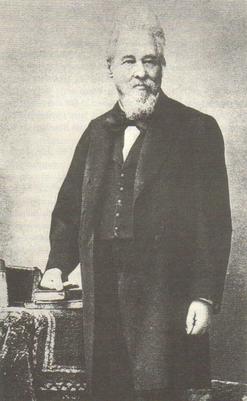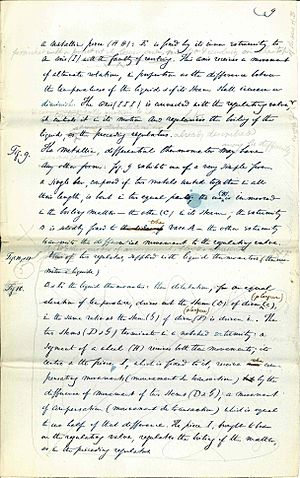Norbert Rillieux facts for kids
Quick facts for kids
Norbert Rillieux
|
|
|---|---|
 |
|
| Born | March 17, 1806 |
| Died | October 8, 1894 (aged 88) |
| Nationality | American / France |
| Alma mater | École Centrale Paris |
| Occupation | Engineer |
Norbert Rillieux (born March 17, 1806 – died October 8, 1894) was an amazing inventor from Louisiana. Many people consider him one of the very first chemical engineers. He is famous for inventing the multiple-effect evaporator, a machine that changed the way sugar was made. This invention was a huge step forward for the sugar industry. Norbert Rillieux was also a cousin of the famous painter Edgar Degas.
Contents
Norbert Rillieux's Family Background
Norbert Rillieux grew up in a well-known Creole family in New Orleans, Louisiana. His father, Vincent Rillieux, was a white plantation owner and inventor. His mother, Constance Vivant, was a free woman of color. Norbert was the oldest of seven children.
His siblings were Barthelemy, Edmond, Marie Eugenie, Louis, Marie Eloise, and Cecile Virginie. Norbert's aunt on his father's side, Marie Celeste Rillieux, was the grandmother of the painter Edgar Degas. Another relative, his cousin Victor E. Rillieux, was a writer who was blind.
His Early Life and Education
As a Creole of color, Norbert Rillieux had chances for education and special treatment that many other free Black people or enslaved people did not have. He was baptized Roman Catholic. He went to private Catholic schools in Louisiana when he was young.
In the early 1820s, he traveled to Paris, France. There, he studied at École Centrale Paris, which was one of the best engineering schools in the country. At École Centrale, Norbert learned about physics, mechanics, and engineering. He became an expert in steam engines. He even wrote several papers about how to use steam to power machines. These early studies helped him create his famous evaporator later on. When he was just 24 years old in 1830, Rillieux became the youngest teacher at École Centrale. He taught about how machines work.
Revolutionizing Sugar Refining
In the 1800s, making sugar from sugarcane was a very slow, costly, and wasteful process. The most common way to do it was called the "Sugar Train." In this method, juice from sugarcane was squeezed out and put into a large kettle. This kettle was heated to make most of the water evaporate.
Workers, many of whom were enslaved, then poured the thick liquid into smaller and smaller pots as it got even thicker. Each time the liquid was poured, some sugar was lost. A lot of sugar also got burned because it was hard to control the heat for the pots. This process was also dangerous for the workers. They had to move the very hot liquid often, risking serious burns.
While in France, Norbert Rillieux started looking for ways to make sugar refining better. He wanted to solve these problems.
Norbert Rillieux kept working on his idea to improve sugar refining. He developed his special machine between 1834 and 1843, when he finally received a patent for it. His invention was called the multiple-effect evaporation system. This system solved many problems. It stopped sugar from being spilled during transfers and made sure the heat was applied evenly. It also made the process much safer for the workers.
Here's how his system worked:
- It uses a vacuum chamber, which is a container with less air inside. This lower air pressure helps liquids boil at a lower temperature.
- Inside the chamber, several pans are stacked on top of each other. These pans hold the sugarcane juice.
- As the bottom pans heat up, they release steam. This steam then transfers heat to the pans above them.
- This way, only one heat source is needed, and it can be at a lower temperature. This prevents the sugar from burning and changing color.
- Since workers don't have to move the hot liquid, less sugar is spilled, and they are much safer from burns.
Norbert Rillieux's invention completely changed how sugar was made. His big scientific discovery was realizing that by lowering the pressure, he could reuse the heat from steam many times. This meant he could make better quality sugar for less money. It was one of the first major breakthroughs in chemical engineering. Rillieux's invention is still seen as the best way to lower the temperature for industrial evaporation and save a lot of fuel.
After patenting his system, Norbert Rillieux successfully set it up at Theodore Packwood's Myrtle Grove plantation. Soon after, his new system was also installed at Bellechasse, another plantation owned by Packwood's business partner, Judah P. Benjamin. Benjamin and Rillieux became good friends.
After these successes, Norbert Rillieux convinced 13 sugar factories in Louisiana to use his invention. By 1849, a company in Philadelphia called Merrick & Towne was offering sugar makers a choice of three different multiple-effect evaporation systems. These machines could make 6,000, 12,000, or even 18,000 pounds of sugar every day! The evaporators were so good that sugar makers could earn back the cost of the new machine very quickly because of the huge profits from the sugar they produced with Norbert Rillieux's system.
Other Important Work
Norbert Rillieux also used his engineering skills to help with a yellow fever outbreak in New Orleans in the 1850s. He presented a plan to the city to get rid of the wet places where mosquitoes, which carried the disease, would breed. His plan involved fixing problems in the city's sewer system and drying out swamplands nearby. However, a state politician named Edmund Forstall blocked his plan. Several years later, engineers used a method very similar to what Rillieux had suggested to deal with the ongoing yellow fever outbreak in New Orleans.
Later Life in France
Norbert Rillieux moved back to France in the late 1850s, a few years before the American Civil War began. One reason for his move might have been the racial issues in the United States. At one point, he became very angry when one of his patent applications was turned down because authorities wrongly thought he was enslaved and therefore not a U.S. citizen.
In Paris, Rillieux became very interested in Egyptology, which is the study of ancient Egypt, and hieroglyphics, which are ancient Egyptian writings. He studied these topics with the family of Jean-François Champollion, a famous expert. He then spent the next ten years working at the Bibliothèque Nationale, a large library.
In 1881, when he was 75 years old, Rillieux worked on sugar evaporation one last time. He changed his multiple-effect evaporation system to extract sugar from sugar beets. The process he patented was much more fuel-efficient than the methods used in French beet sugar factories at the time. Before Rillieux's invention, two other engineers tried to improve the process, but their machine didn't work well because steam was used in the wrong places. Rillieux's process fixed these errors. However, he later lost the rights to the patent he had filed.
Norbert Rillieux passed away on October 8, 1894, at the age of 88. He is buried in Père Lachaise Cemetery in Paris. His tombstone has an inscription that says, "Here rests Norbert Rillieux, civil engineer, born in New Orleans March 18, 1806 / died in Paris October 8, 1894 / Emily Cuckow, Widow Rillieux 1827-1912." His wife, Emily Cuckow, died in 1912 and is buried next to him.
To honor him, a bronze memorial was placed in the Louisiana State Museum. It reads: "To honor Norbert Rillieux, born at New Orleans, Louisiana, March 17, 1806, and died at Paris, France, October 8, 1894. Inventor of Multiple Evaporation and Its Application to the Sugar Industry."
Images for kids




